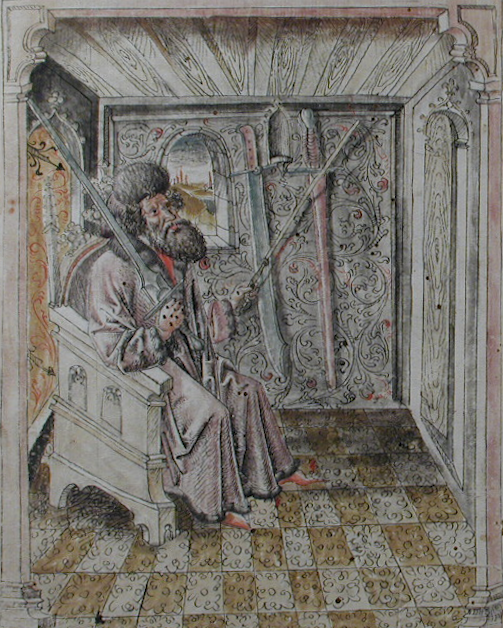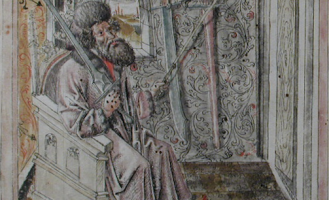Johannes Liechtenauer – fencing master from 14th and presumably the beginning of 15th century. He taught in the German states and is often referred to as the grand master as well as the founder of the German fencing tradition.

Little is known about the life and activity of J. Liechtenauer. There is currently no confirmed information which could be connected to his birth or death. At the moment, the only legitimate record of his activity comes from the Nuremberg Codex—Pol Hausbuch1.
Researchers claim that there is a possibility that J. Liechtenauer could live in the years when the Nuremberg Codex was drawn up as there is no characteristic phrase next to his name: dem got gnadig sey (May God have mercy upon him), which at the time was used to honour the deceased2.
The Nuremberg Codex shows that it is J. Liechtenauer to whom we owe the systematisation of the knowledge on fencing in the ancient Reich. This is evinced by the following words: And before all things you should know and understand that the sword is only one art and it was devised and thought out hundreds of years ago. This art is the foundation and core and it was completely understood and known by Master Liechtenauer […]. Not that he himself devised or thought out what is described, but he travelled and searched through many lands since he wanted to learn and experience this art3.
The knowledge acquired during these travels was imparted by J. Liechtenauer to his students in the form of the so-called Zettel (Recital), i.e. enigmatic rhymes through which the most important information on the proper use of weapon was conveyed. The rhymed verses of the Recital aimed to help those initiated into the teachings of J. Liechtenauer remember its content, at the same time hindering its understanding for those who could use the art in a wrongful way. Such persons included leychmeistere i.e. „false” fencing masters, who taught show fighting/choreography4.
The reason behind J. Liechtenauer’s “secreting of fencing knowledge” is explained by the words from Peter von Danzig’s treatise: Because the art belongs to princes and lords, knights and squires, and they should know and learn this art, he has written of this art in hidden and secret words, so that not everyone will grasp and understand it, as you will find described below. And he has done this on account of frivolous fight masters who mistake the art as trivial, so that such masters will not make his art common or open with people who do not hold the art in respect as is its due5.
There are no indications suggesting that J. Liechtenauer wrote down his teachings himself. They have survived to this day thanks to the later masters of the German tradition, who referred to the founder of the German school in their own teachings. The oldest written versions of the Liechtenauer Recital are known from manuscripts such as the “Nuremberg Codex” (1389-1494)6, Modus Dimicandi by Magister H. Beringer (1418-1428)7, or Talhoffers Fechtbuch by Hans Talhoffer dated to 14488.
Verses of the Recital encompass the following teachings: (1) fighting with the sword on foot without armour—Blossfechten; (2) fighting with spear and sword in half-sword grip on foot with armour—Harnischfechten; or (3) mounted fighting—Rossfechten.
It is assumed that after the death of J. Liechtenauer, in fear of losing the knowledge accumulated by him, as well as with the aim of gaining recognition, later fencing masters began creating extensive commentaries (so called “glosses”) to the Recital’s verses. In this way, the written knowledge constituted the basis for learning the German fencing tradition for at least the next two centuries.
The influence of J. Liechtenauer on the German fencing tradition is enormous. The terms “German tradition”, “German school”, or “Liechtenauer’s school” are generally tantamount. Fencing masters from the medieval German states refer in a more or less direct way to the teachings of J. Liechtenauer. One of the examples is the The Society of Liechtenauer—a group to which Paulus Kal assigns seventeen fencing masters, who he presumes took lessons from J. Liechtenauer himself9—and the activity of medieval and renaissance fencing brotherhoods such as Marxbruder or Federfechter10.
/$DirectLink&sp=SOPAC&sp=SAK00204645, [DOA 16.05.2020] and Wiktenauer. A Hema Alliance Project, Pol Hausbuch (MS 3227a), https://wiktenauer.com/wiki/Pol_Hausbuch_(MS_3227a)#cite_note-1, [DOA 19.05.2020].

